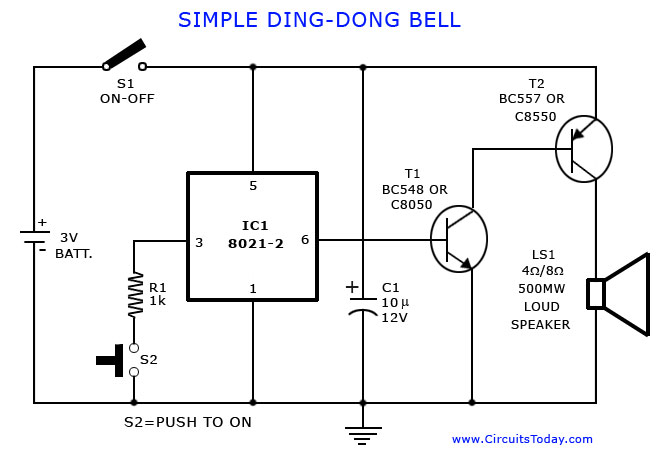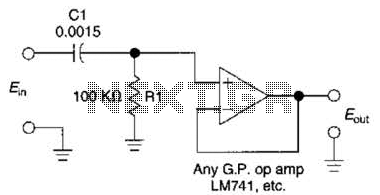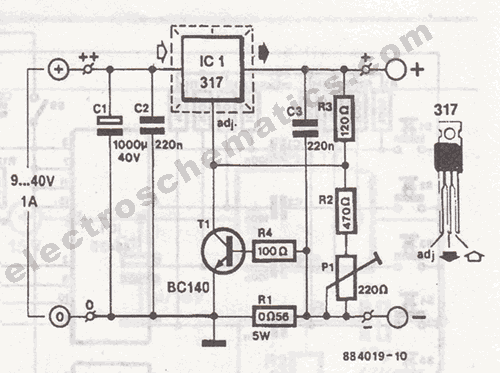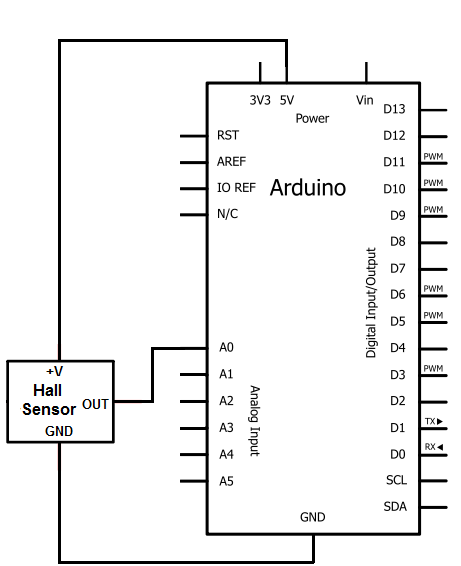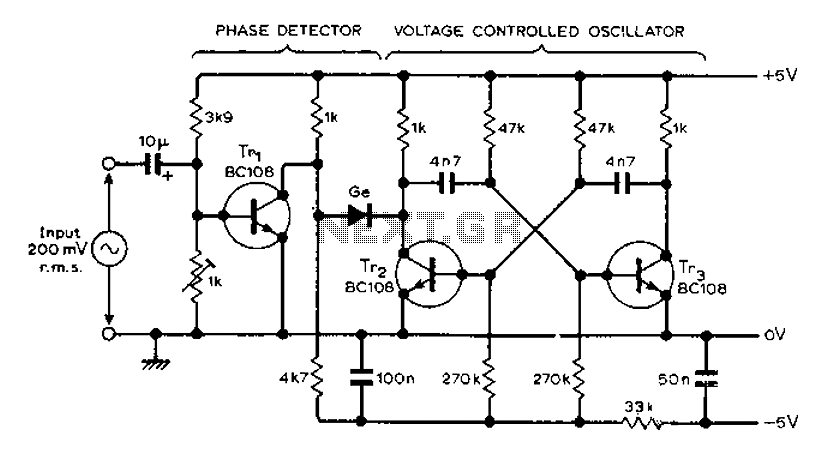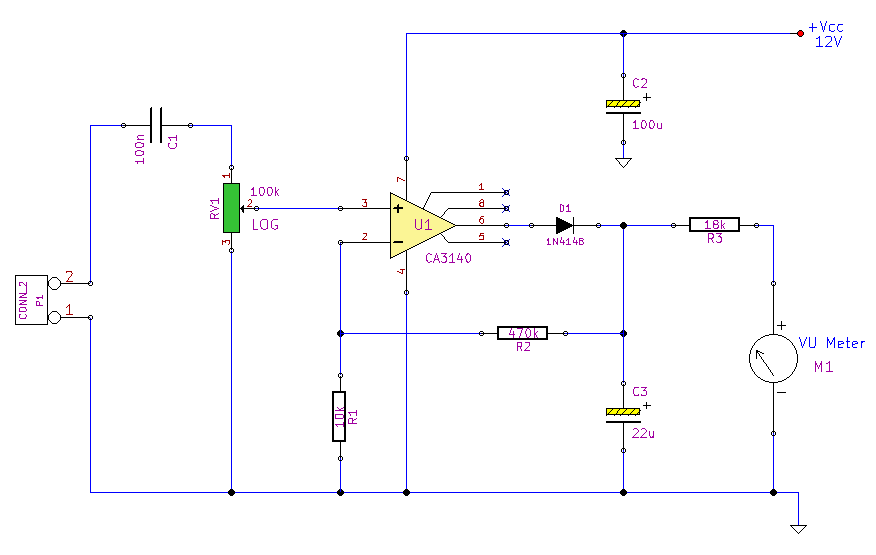
TV audio video transmitter circuit design project
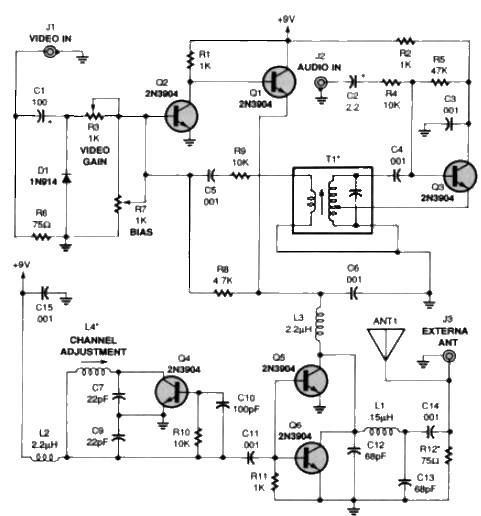
A simple TV audio-video transmitter circuit can be designed using this schematic diagram. This circuit can transmit video signals from a VCR or other devices to a TV without the need for cables. Video signals input at jack J1 are first terminated by resistor R6 and coupled through capacitor C1 to the clamping diode D1. Potentiometer R3 is used to adjust the gain of the video signal, functioning similarly to the contrast control on a TV set. The RF transformer T1 and its internal capacitor create the tank circuit of a Hartley oscillator tuned to 4.5 megahertz. Audio signals input at J2 are coupled to the base of transistor Q3 via capacitor C2 and resistor R4, where the audio signal modulates the base signal of Q3 to form an audio subcarrier that is 4.5 megahertz higher than the video carrier frequency. Transistors Q1 and Q2 amplitude modulate the video and audio signals onto an RF carrier signal. The operating frequency is determined by coil L4, which consists of 3.5 turns of 24-gauge enameled wire on a form containing a standard ferrite slug. The RF output from the oscillator section (L4, C7, and C9) is amplified by transistors Q5 and Q6, with their supply voltage sourced from the modulator. Antenna matching and low-pass filtering are achieved using capacitors C12, C13, and inductor L1. To align the audio-video transmitter, a TV receiver should be tuned to an unused channel between 2 and 6, with an indoor antenna connected directly. Both potentiometers (R3 and R7) should be set to the middle position before powering the transmitter. Adjust L4 with a non-metallic tool until the TV screen goes blank, then fine-tune L4 for the "most-blank" picture. A picture should appear on the TV screen; if not, check the board for any faulty connections. Afterward, adjust R3 for optimal picture brightness and R7 for the best overall picture quality. The TV transmitter combines line-level audio and video signals, transmitting the resulting signal up to 300 feet. The circuit operates on a power supply of 9-12V.
The schematic for the TV audio-video transmitter circuit consists of several key components that work together to achieve wireless transmission of audio and video signals. The input stage begins with jack J1, where video signals are received. Resistor R6 serves to terminate the input, preventing signal reflections that could degrade performance. Capacitor C1 is crucial for coupling the video signal to the clamping diode D1, which ensures that the video signal maintains appropriate amplitude levels.
The gain of the video signal is adjustable via potentiometer R3, allowing for fine-tuning of the contrast, akin to the functionality found in standard television sets. The RF transformer T1, along with its internal capacitor, forms a tank circuit that is vital for generating the Hartley oscillator's output frequency, specifically tuned to 4.5 megahertz.
The audio input is connected through jack J2, where the audio signal is coupled to the base of transistor Q3 using capacitor C2 and resistor R4. This configuration allows the audio signal to modulate the base of Q3, creating an audio subcarrier that is offset from the video carrier frequency, thereby facilitating simultaneous transmission of both audio and video.
Transistors Q1 and Q2 play a significant role in the amplitude modulation process, combining the modulated audio and video signals onto a single RF carrier signal. Coil L4's design, with its specific number of turns and the use of a ferrite slug, is critical in setting the operating frequency of the transmitter. The output stage includes transistors Q5 and Q6, which amplify the RF output from the oscillator section, ensuring sufficient signal strength for transmission.
For effective antenna matching and to filter out unwanted frequencies, capacitors C12, C13, and inductor L1 are employed. The alignment process is essential for optimal performance, requiring careful tuning of the TV receiver to an unused channel. The described procedure for tuning ensures that the transmitter operates without interference, allowing for clear reception of the transmitted signals.
The circuit's operational voltage range of 9-12V makes it versatile for various power supply configurations, while its ability to transmit signals over a distance of up to 300 feet adds to its practical utility in wireless audio-video applications. Overall, the design exemplifies a straightforward yet effective approach to constructing a wireless TV audio-video transmitter.A very simple TV audio video transmitter circuit can be designed using this schematic diagram. This TV audio video transmitter circuit can be used to transmit video signals from VCR ( or some other device ) to a TV without using any cable. Video signals input at jack J1 are first terminated by resistor R6 and coupled through capacitor C1 to clam
ping-diode D1. Potentiometer R3 is used to set the gain of the video signal; its effect is similar to that of the contrast control on a TV set. RF-transformer T1 and its internal capacitor form the tank circuit of a Hartley oscillator that`s tuned to 4.
5 megahertz. Audio signals input at J2 are coupled to the base of Q3 via C2 and R4: the audio signal modulates the base signal of Q3 to form an audio subcarrier thats 4. 5-megahertz higher than the video-carrier frequency. Transistors Q1 and Q2 amplitude modulate the video and audio signals onto an RF-carrier signal. The operating frequency is set by coil L4, which is 3. 5 turns of 24- gauge enameled wire on a form containing a standard ferrite slug. The RF output from the oscillator (L4, C7 and C9 ) section is amplified by Q5 and Q6, whose supply voltage comes from the modulator.
Antenna matching and low-pass filtering is performed by C12, C13, and L1. To align this audio video transmitter you need to tune a TV receiver to an unused channel between 2 and 6. The TV must have an indoor antenna connected directly to it; an outdoor antenna or cable won`t work. Make sure both potentiometers (R3, R7) are in middle position and apply power to the transmitter. Adjust L4 with a nonmetallic tool until the TV screen goes blank, then fine-adjust L4 for the "most-blank" picture.
After that you should see a picture on the TV screen: if you do, readjust L4 for the best picture; if you don`t, check the board for any bad connections. Next, adjust R3 for the best picture brightness and R7 for the best overall picture. The TV transmitter combines line level audio and video signals, and transmits the resulting signal up to 300 feet.
The circuit can be powered from a 9-12V power supply circuit. 🔗 External reference
The schematic for the TV audio-video transmitter circuit consists of several key components that work together to achieve wireless transmission of audio and video signals. The input stage begins with jack J1, where video signals are received. Resistor R6 serves to terminate the input, preventing signal reflections that could degrade performance. Capacitor C1 is crucial for coupling the video signal to the clamping diode D1, which ensures that the video signal maintains appropriate amplitude levels.
The gain of the video signal is adjustable via potentiometer R3, allowing for fine-tuning of the contrast, akin to the functionality found in standard television sets. The RF transformer T1, along with its internal capacitor, forms a tank circuit that is vital for generating the Hartley oscillator's output frequency, specifically tuned to 4.5 megahertz.
The audio input is connected through jack J2, where the audio signal is coupled to the base of transistor Q3 using capacitor C2 and resistor R4. This configuration allows the audio signal to modulate the base of Q3, creating an audio subcarrier that is offset from the video carrier frequency, thereby facilitating simultaneous transmission of both audio and video.
Transistors Q1 and Q2 play a significant role in the amplitude modulation process, combining the modulated audio and video signals onto a single RF carrier signal. Coil L4's design, with its specific number of turns and the use of a ferrite slug, is critical in setting the operating frequency of the transmitter. The output stage includes transistors Q5 and Q6, which amplify the RF output from the oscillator section, ensuring sufficient signal strength for transmission.
For effective antenna matching and to filter out unwanted frequencies, capacitors C12, C13, and inductor L1 are employed. The alignment process is essential for optimal performance, requiring careful tuning of the TV receiver to an unused channel. The described procedure for tuning ensures that the transmitter operates without interference, allowing for clear reception of the transmitted signals.
The circuit's operational voltage range of 9-12V makes it versatile for various power supply configurations, while its ability to transmit signals over a distance of up to 300 feet adds to its practical utility in wireless audio-video applications. Overall, the design exemplifies a straightforward yet effective approach to constructing a wireless TV audio-video transmitter.A very simple TV audio video transmitter circuit can be designed using this schematic diagram. This TV audio video transmitter circuit can be used to transmit video signals from VCR ( or some other device ) to a TV without using any cable. Video signals input at jack J1 are first terminated by resistor R6 and coupled through capacitor C1 to clam
ping-diode D1. Potentiometer R3 is used to set the gain of the video signal; its effect is similar to that of the contrast control on a TV set. RF-transformer T1 and its internal capacitor form the tank circuit of a Hartley oscillator that`s tuned to 4.
5 megahertz. Audio signals input at J2 are coupled to the base of Q3 via C2 and R4: the audio signal modulates the base signal of Q3 to form an audio subcarrier thats 4. 5-megahertz higher than the video-carrier frequency. Transistors Q1 and Q2 amplitude modulate the video and audio signals onto an RF-carrier signal. The operating frequency is set by coil L4, which is 3. 5 turns of 24- gauge enameled wire on a form containing a standard ferrite slug. The RF output from the oscillator (L4, C7 and C9 ) section is amplified by Q5 and Q6, whose supply voltage comes from the modulator.
Antenna matching and low-pass filtering is performed by C12, C13, and L1. To align this audio video transmitter you need to tune a TV receiver to an unused channel between 2 and 6. The TV must have an indoor antenna connected directly to it; an outdoor antenna or cable won`t work. Make sure both potentiometers (R3, R7) are in middle position and apply power to the transmitter. Adjust L4 with a nonmetallic tool until the TV screen goes blank, then fine-adjust L4 for the "most-blank" picture.
After that you should see a picture on the TV screen: if you do, readjust L4 for the best picture; if you don`t, check the board for any bad connections. Next, adjust R3 for the best picture brightness and R7 for the best overall picture. The TV transmitter combines line level audio and video signals, and transmits the resulting signal up to 300 feet.
The circuit can be powered from a 9-12V power supply circuit. 🔗 External reference
